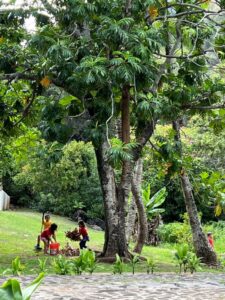Company breaks ground on largest solar project in state
Kuihelani Solar set to come online in 2023, can power 27K homes
Developers broke ground in Central Maui on Friday for the largest solar project planned in the state, a 60-megawatt solar, 240-megawatt-hour battery storage system that will have the capacity to power 27,000 homes on Maui.
Kuihelani Solar will be built on 450 acres of old sugar cane lands leased from Mahi Pono between Kuihelani and Maui Veterans highways. It’s expected to come online by October 2023.
“We’re just really excited. It’s taken a tremendous amount of collaboration with our partners, and our team has worked really hard to get all the approvals in place really to get us to where we are today,” Sandra Larsen, Hawaii market business leader for project developer AES, said ahead of the groundbreaking Friday.
Bernerd Da Santos, executive vice president and chief operating officer for AES Corporation, said that as Hawaii transitions to 100 percent renewable sources, it needs to keep up a reliable system of supplying energy.
“You achieve that by having projects lined up like this in order to establish the reliability through solar, plus in this case, battery. Energy storage solutions that actually give you the opportunity to cover not only the day hours, that is when the solar is present, but also the shoulders,” Da Santos said, referring to the sunrise and sunset hours when people are home and demand is high.
Kuihelani Solar was one of two Maui projects chosen after Hawaiian Electric Cos. put out a request for proposals in 2018 seeking renewable energy projects.
The state Public Utilities Commission approved Kuihelani Solar in 2019, and the Maui Planning Commission unanimously granted a special use permit for the project in November of last year.
Earlier this year, however, Kuihelani Solar appeared to be at risk of missing its guaranteed commercial operations date of Oct. 27, 2023, according to a status report of projects across the state provided to the Public Utilities Commission. AES said it was monitoring supply chain impacts due to the pandemic and raised concerns about a U.S. Customs and Border Protection order potentially impacting the delivery of solar panels.
However, Da Santos said the company was able to address supply issues by directing equipment toward projects that were set to come online in 2022 and 2023. It’s also working to close the gap for projects set to be operational in 2024.
“We have observed some delays, but the delays that we have observed are not meaningful to change the strategy or to create a disruption in the delivery of our project,” Da Santos said. “I’m talking worldwide but more importantly here in Hawaii.”
He said the project has all its permits and approvals and that “I don’t see any reason to not fulfill that commitment” to be operational by October 2023. From there, the project has a 25-year power purchase agreement to feed into the Hawaiian Electric grid on Maui at a cost of 8 cents per kilowatt-hour, one of the lowest rates in the state for renewable energy, according to project documents.
It will have the capacity to power about 15 percent of the island’s energy needs. While early solar projects on Maui focused primarily on supplying solar, more recent projects have also included battery storage as Hawaiian Electric and solar developers look to make the energy supply more reliable when the sun’s not out.
“This project is intended to dispatch every day with emergency or without it,” Da Santos said. “It’s designed to have that resiliency.”
The project will also allow for agricultural uses as well. Larsen said they’re looking into having herds of sheep that can graze under the panels, as well as maybe beekeeping operations.
As Maui sees more renewable energy developments and solar projects continue to expand, some residents have raised concerns about their size and impacts to nearby communities. Kuihelani Solar hasn’t run into the same legal challenges as Paeahu Solar, a 15-megawatt solar, 60-megawatt-hour battery storage project in South Maui that was chosen around the same time as Kuihelani and has drawn complaints by neighbors. However, Larsen said that after AES received community feedback raising concerns over Kuihelani Solar’s footprint, the developer redesigned the project to keep the energy capacity but reduce the amount of land by 35 percent.
For more information on the project, visit kuihelanisolar.com.
* Colleen Uechi can be reached at cuechi@mauinews.com.
- Dignitaries break ground for Kuihelani Solar, a 60-megawatt photovoltaic system with 240 megawatt hours of battery storage that will be Maui’s largest solar electric producer when completed. — The Maui News / MATTHEW THAYER photo
- Vene Chun hands AES Corporation’s Executive Vice President and Chief Operating Officer Bernerd Da Santos an o‘o digging stick to use for Friday afternoon’s groundbreaking for the Kuihelani Solar energy project in Central Maui. The 60-megawatt solar, 240-megawatt-hour battery storage project is currently the largest planned in the state. — The Maui News / MATTHEW THAYER photo







